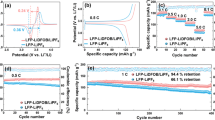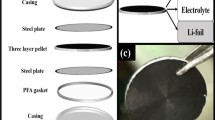Abstract
Lithium bis(oxalate)borate (LiBOB) is a promising salt for lithium-ion batteries. However, it is necessary to exert the electrochemical performance of LiBOB by the appropriate solvent. With dimethyl sulfite (DMS) as mixed solvents, the electrochemical behavior of γ-butyrolactone (GBL) with LiBOB is studied in this paper. It shows that LiBOB-GBL/DMS electrolyte has high oxidation potential (>5.3 V) and satisfactory conductivities. When used in lithium and mesophase carbon microbead cells, the novel electrolyte exhibits not only excellent film-forming characteristics but also low impedances of the interface films. Besides, when used in LiFeO4/Li cells, compared to the cell with the electrolyte system of 1 mol L−1 LiPF6–ethylene carbonate (EC)/dimethyl carbonate (DMC) (1:1, v/v), LiBOB-based electrolyte exhibits several advantages, such as more stable cycle performance at room temperature and higher mean voltage.







Similar content being viewed by others
References
Xu K (2004) Nonaqueous liquid electrolytes for lithium-based rechargeable batteries. Chem Rev 104:4303–4418
Caballero A, Cruz M, Hernán L, Melero M, Morales J, Castellón ER (2005) Oxygen Deficiency as the Origin of the Disparate Behavior of LiM0.5Mn1.5O4 (Mıı=ıNiı,ıCu) Nanospinels in Lithium Cells. J Electrochem Soc 152:A552–A559
Jo M, Lee YK, Kim KM, Cho J (2010) Nanoparticle–Nanorod Core–Shell LiNi0.5Mn1.5O4 Spinel Cathodes with High Energy Density for Li-Ion Batteries. J Electrochem Soc 157:A841–A845
Huang XK, Zhang QS, Gan JL, Chang HT, Yang Y (2011) Hydrothermal Synthesis of a Nanosized LiNi0.5Mn1.5O4 Cathode Material for High Power Lithium-Ion Batteries. J Electrochem Soc 158:A139–A145
Whittingham MS (2004) Lithium Batteries and Cathode Materials. Chem Rev 104:4271–4302
Li JG, Zhang YY, Li JJ (2011) AlF3 coating of LiNi0.5Mn1.5O4 for high-performance Li-ion batteries. Ionics 17:671–675
Ha SY, Han JG, Song YM, Chun MJ, Han SI, Shin WC, Choi NS (2013) Using a lithium bis(oxalato) borate additive to improve electrochemical performance of high-voltage spinel LiNi0.5Mn1.5O4 cathodes at 60 °C. Electrochim Acta 104:170–177
Xu K, Lee U, Zhang SS, Wood M, Jow TR (2003) Chemical Analysis of Graphite/Electrolyte Interface Formed in LiBOB-Based Electrolytes. Electrochem Solid SL 6:A144–148
Panitz JC, Wietelmann U, Wachtler M, StrÖbele S, Mehrens MW (2006) Film formation in LiBOB-containing electrolytes. J Power Sources 153:396–401
Chen Z, Lu WQ, Liu J, Amine K (2006) LiPF6/LiBOB blend salt electrolyte for high-power lithium-ion batteries. Electrochim Acta 51:3322–3326
Lebdeh YA, Davidson I (2009) High-Voltage Electrolytes Based on Adiponitrile for Li-Ion Batteries. J Electrochem Soc 156:A60–A65
Duncan H, Salem N, Lebdeh YA (2013) Electrolyte Formulations Based on Dinitrile Solvents for High Voltage Li-Ion Batteries. J Electrochem Soc 160:A838–A848
Holomb R, Xu W, Markusson H, Johansson P, Jacobsson P (2006) Vibrational Spectroscopy and ab Initio Studies of Lithium Bis(oxalato)borate (LiBOB) in Different Solvents. J Phys Chem A 110:11467–11472
Lebdeh YA, Davidson I (2009) New electrolytes based on glutaronitrile for high energy/power Li-ion batteries J Power Sources 189:576–579
Zhang SS, Xu K, Jow TR (2005) Electrochemical impedance study of graphite/electrolyte interface formed in LiBOB/PC electrolyte. J Power Sources 143:197–202
Xu K (2008) Tailoring Electrolyte Composition for LiBOB. J Electrochem Soc 155:A733–A738
Fadhel A, Peter SF (2010) Conductivity of libob-based electrolyte for lithium-ion batteries. J Power Sources 195:7627–7633
Huang JY, Liu XJ, Kang XL, Yu ZX, Xua TT, Qiu WH (2009) Study on γ-butyrolactone for LiBOB-based electrolytes. J Power Sources 189:458–461
Ping P, Wang QS, Sun JH, Feng XY, Chen CH (2011) Effect of sulfites on the performance of LiBOB/γ-butyrolactone electrolytes. J Power Sources 196:776–783
Mao LP, Li BC, Cui XL, Zhao YY, Xu XL, Shi XM, Li SY, Li FQ (2012) Electrochemical performance of electrolytes based upon lithium bis(oxalate)borate and sulfolane/alkyl sulfite mixtures for high temperature lithium-ion batteries. Electrochim Acta 79:197–201
Li SY, Zhao YY, Shi XM, Li BC, Xu XL, Zhao W, Cui XL (2012) Effect of sulfolane on the performance of lithium bis(oxalato)borate-based electrolytes for advanced lithium ion batteries. Electrochim Acta 65:221–227
Yu BT, Qiu WH, Li FS, Cheng L (2006) A study on sulfites for lithium-ion battery electrolytes. J Power Sources 158:1373–1378
Larsson W, Panitz JC, Cedergren A (2006) Interference-free coulometric titration of water in lithium bis(oxalato)borate using Karl Fischer reagents based on N-methylformamide. Talanta 69:276–280
Fan LZ, Xing TF, Awan R, Qiu WH (2011) Studies on lithium bis(oxalato)-borate/propylene carbonate-based electrolytes for Li-ion batteries. Ionics 17:491–494
Ding MS, Jow TR (2004) How Conductivities and Viscosities of PC-DEC and PC-EC Solutions of LiBF4, LiPF6, LiBOB, Et4NBF4, and Et4NPF6 Differ and Why. J Electrochem Soc 151:A2007–A2015
Zhang SS (2007) Electrochemical study of the formation of a solid electrolyte interface on graphite in a LiBC2O4F2-based electrolyte. J Power Sources 163:713–718
Li SY, Zhao W, Cui XL, Zhao YY, Li BC, Zhang HM, Li YL, Li GX, Ye XS, Luo YC (2013) An improved method for synthesis of lithium difluoro(oxalato)borate and effects of sulfolane on the electrochemical performances of lithium-ion batteries. Electrochim Acta 91:282–292
Acknowledgments
This work was supported by the Science and Technology Planning Project of Gansu Province (110RJYA056), the Foundation of Knowledge Innovation Program of Chinese Academy of Sciences ( kzcx2-ew-qn309), and the Natural Science Foundation of China ( 51063003).
Author information
Authors and Affiliations
Corresponding author
Rights and permissions
About this article
Cite this article
Cui, X., Zhang, H., Li, S. et al. Electrochemical performances of a novel lithium bis(oxalate)borate-based electrolyte for lithium-ion batteries with LiFePO4 cathodes. Ionics 20, 789–794 (2014). https://doi.org/10.1007/s11581-013-1034-7
Received:
Revised:
Accepted:
Published:
Issue Date:
DOI: https://doi.org/10.1007/s11581-013-1034-7




